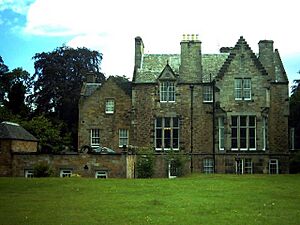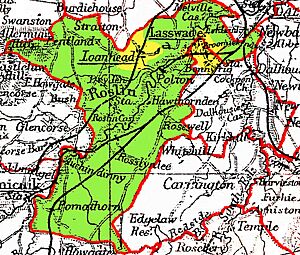Lasswade facts for kids
Quick facts for kids Lasswade |
|
|---|---|
 Pittendreich House, Lasswade by David Bryce |
|
| OS grid reference | NT301661 |
| Council area | |
| Lieutenancy area | |
| Country | Scotland |
| Sovereign state | United Kingdom |
| Post town | LASSWADE |
| Postcode district | EH18 |
| Dialling code | 0131 |
| Police | Lothian and Borders |
| Fire | Lothian and Borders |
| Ambulance | Scottish |
| EU Parliament | Scotland |
| UK Parliament |
|
| Scottish Parliament |
|
Lasswade is a village in Midlothian, Scotland. It sits by the River North Esk, about 14.5 kilometres (9 miles) south of Edinburgh. Lasswade is very close to Bonnyrigg, and it's located between Dalkeith to the east and Loanhead to the west.
The village is part of the Edinburgh Green Belt, which means it's surrounded by protected natural areas. Many people who live in Lasswade travel to Edinburgh for work. However, there are also some local businesses. These include places for horse riding, golf courses, a plant nursery, a pub, and a restaurant. Lasswade also has its own athletics club, started in 1981.
Contents
What's in a Name?
The name Lasswade might come from old languages. One idea is that it comes from a Brittonic (an ancient British language) word meaning "a court or palace" and "a wood." Another idea is that it comes from Old English words meaning "pasture" and "a ford" (a shallow place to cross a river).
Even though people might have lived here since the 700s, the name "Leswade" was first written down in 1150. On an old map from 1750, it was spelled "Laswaid." Back then, people spelled words how they sounded, so spellings often changed.
There's a fun legend about how Lasswade got its name. It's said that before there was a bridge, a strong local girl named Jenny would carry travelers across the river on her back. A short poem tells the story:
When there was nae Brig to cross the Esk river,
On Jenny’s braid back they a’ gaed the gither,
For Jenny was honest, stout, sober and steady
She carried the Laird, she carried his leddy,
Whin he was richt seated the doggie first gaed,
Then waving his stick he cried “Jenny Lass – Wade!”
A Look Back in Time
The original parish church in Lasswade was built in the 1200s, but not much of it is left today. It was left empty in 1793, and parts of it fell down in 1866. A Scottish poet from the 1600s, William Drummond of Hawthornden, is buried there.
The first paper mill in Lasswade was built in 1750. Making paper was a very important industry for the village until the early 1900s.
Many famous people have lived in or visited Lasswade. Sir John Lauder, 1st Baronet was born nearby in 1595. The famous writer Walter Scott rented a house here from 1798 to 1804. Other writers like James Hogg and the Wordsworths visited him there. Thomas de Quincey also lived nearby for several years. The Scottish artist William McTaggart moved to Lasswade in 1889, and many of his later paintings show the local Moorfoot Hills.
In the 1800s, Lasswade had paper mills, flour mills, and even a carpet factory. It became a "police burgh" in 1881, which meant it could manage some of its own local affairs. Later, in 1929, Lasswade joined with Bonnyrigg. In the 1800s, Lasswade was a popular holiday spot for rich people from Edinburgh. But by the 1950s, many people moved to newer homes in Bonnyrigg.
Important Buildings
The old church before the Reformation was named after St Edwin.
The main Lasswade Parish Church building we see today was built in 1830. It was first a simple chapel. It was changed and improved in 1894 and became part of the Church of Scotland in 1929. The church has used this building since 1956 because the older church had problems and was later taken down.
St Leonard's Episcopal Church, built in 1890, is another notable building.
The old school building from 1875 stands on a hill with great views of the village. It has now been turned into apartments. Lasswade High School moved to its current location in Bonnyrigg in 1956, and a new building was built on the same site in 2013.
The Lasswade Area
The parish of Lasswade is a larger area that includes the village. It stretches about 7 miles from north to south. The River North Esk flows through the middle of the parish.
Important old places within the parish include Rosslyn Chapel, Hawthornden Castle, and Melville Castle.
The parish includes the villages of Lasswade, Roslin, and Rosewell. It also includes the small town of Loanhead and part of Bonnyrigg.
Lasswade is one of the oldest parishes in Scotland. There is evidence from burial grounds that a church was active here as early as the 800s.
In the past, the area was made up of three smaller parishes: Lasswade, Melville, and Pentland. Over time, these areas were combined or divided. For example, the Melville area joined Lasswade in 1633.
Local councils called "Parish Councils" used to manage parts of the area. Also, "police burghs" like Lasswade and Loanhead were created. These were communities large enough to manage their own local services, like street lighting and public order. These councils were later changed or removed, but the "civil parish" area still exists for things like census records.
The civil parish of Lasswade has a population of over 18,000 people and covers a large area of land.
Famous Faces
Many interesting people have connections to Lasswade:
- Archibald Thorburn, a famous artist who painted wildlife.
- Richard Baird Smith, an important officer in the East India Company who took part in the Siege of Delhi. There's a monument to him near the Old Kirkyard.
- Pilkington Jackson, a sculptor who created the monument of Robert the Bruce at Bannockburn.
- Margaret Calderwood, a diarist who wrote about her life.
- Professor Alexander Campbell Fraser, a philosopher.
- John Ivor Murray, born here in 1824, was a Fellow of the Royal Society of Edinburgh.
- William McTaggart, a well-known painter.
- John Notman, an architect and landscape architect.
Notable Persons Buried in Lasswade
Some important people are buried in Lasswade:
- Seven Viscounts Melville, who were noblemen.
- Charles Clough (geologist), a geologist.
- Reverend Walter Gregor.
- Sir Robert Preston of Valleyfield.
- Sir William Calderwood, Lord Polton.
- William Drummond of Hawthornden, the poet mentioned earlier.





